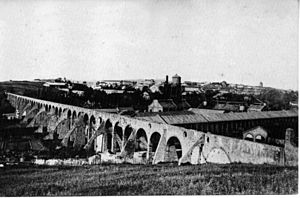Aqueduct of Algeciras facts for kids
Quick facts for kids Aqueduct of AlgecirasAqüeducte de les Ferreres |
|
|---|---|

Old photograph of the aqueduct.
|
|
| Coordinates | 36°07′03″N 5°28′24″W / 36.11750°N 5.47333°W |
| Carries | Aqueduct to Algeciras |
| Locale | Algeciras, Spain |
| History | |
| Construction begin | 1777 |
| Construction end | 1783 |
The Aqueduct of Algeciras (which means 'Aqueduct of Algeciras' in Spanish) is a very important old structure in Algeciras, Spain. Many books and guides sometimes say it's from Roman or Arabic times. But actually, it was built much later, in the 1700s!
Contents
What is the Aqueduct of Algeciras?
This aqueduct was built to bring fresh water to the city of Algeciras. Building started in 1777 and finished in 1783. For a long time, pictures of the aqueduct with its arches and Gibraltar in the background were very popular postcards of the city.
How the Aqueduct was Built
The aqueduct had two main parts. One part was further away, in an area called El Cobre. This section is known as Los Arcos del Cobre, meaning "The Arches of El Cobre." The other part was closer to the city, in the La Bajadilla neighborhood. Much of this section has disappeared over time. Many new buildings have been built around it. Today, the aqueduct still passes through the La Bajadilla neighborhood.
The main person in charge of designing the aqueduct was an architect named Pablo Casaus. He worked with a master plumber named Florindo. Florindo had just finished building a similar water system in another town called Puerto Real. The aqueduct is made of strong stone and brick, with special supports called buttresses.
Why the Aqueduct was Important
In 1911, people described the Aqueduct of Algeciras as "beautiful." It was the main way the city got its water. Back then, many people visited Algeciras because of its nice winter weather. The aqueduct helped make sure the city had enough water for everyone, including visitors.
See also
 In Spanish: Acueducto de Algeciras para niños
In Spanish: Acueducto de Algeciras para niños





